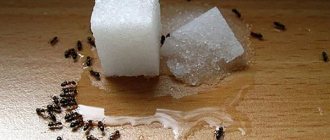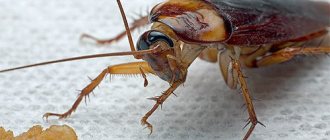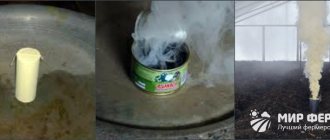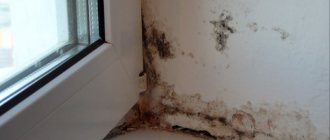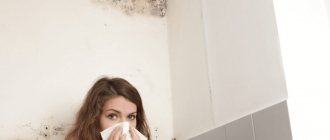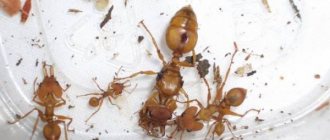How to remove mold on clothes using household chemicals
Professional solutions will help remove mold from fabric. They effectively fight fungal stains on all fabrics. They must be used strictly according to the instructions:
- Domestos. 1 tbsp. You need to dilute it in half a liter of water and boil it. The soiled clothes are placed in the resulting hot mixture. After half an hour, the item is taken out and washed.
- News. This is a powder that effectively removes mold stains and removes musty odors from clothes made from natural materials. 50 ml of product is diluted in 3 liters of water, things are soaked, after about an hour they are rinsed and washed.
- White. Copes with old stains on light-colored clothes. 1 tbsp dissolves in half a liter of hot water. liquids, boils, soaks clothes. After 15 minutes the spots will disappear.
- Nanny. Using this bleach for baby clothes, you can wash off fresh mold. 1 tbsp. the composition is dissolved in a glass of boiling water, soda (3 tbsp) and salt (1 tsp) are added. The fungal stain should be wiped with a sponge soaked in liquid and washed off after a quarter of an hour. If necessary, the procedure is repeated a couple of times.
- Ariel Mountain spring. The contaminated area of fabric is held under the pressure of hot water from the tap. Next, 100 g of powder is mixed and the soiled item is soaked. After an hour, it is pulled out and placed in an automatic washing machine for further washing.
- Vanish. It is better to take a powdered product from which a creamy mass is prepared, applied to the area with the fungus, and washed off after half an hour. Next, the product is washed using the usual method.
How not to harm clothes when eliminating fungus
An important condition is that in order not to harm the fibers of non-ferrous materials, it is necessary to carry out testing. Pour the indicated product from the wrong side of the clothing. If the shade has not changed, you can apply it to the entire area of the item of clothing or linen.
Different types of fabric
Ammonia will help remove mold on colored or synthetic clothing. A 1:1 ratio with water is required. Treat traces with the composition using a cotton swab dipped in the solution. Leave for 5-7 minutes and wash with laundry soap. First make a test from the inside out.
Delicate fabrics can be thoroughly cleaned with turpentine. You should moisten the cotton wool and gently rub it over the contaminated areas of the material. Then sprinkle with clay. Wait 10 minutes. Wash by hand or machine with powder.
Silk tulle and a spore blanket will help clean ammonia. Dilute the solution with water in a ratio of 1:16. Moisten the marks with a cotton swab. Wait 30-60 seconds, rinse with water. Wash by hand with soapy water.
Woolen clothes are perfectly treated with turpentine. Soak a cotton swab in the solution and lightly rub the mark. Cover the area with clay, put paper on top and iron it. Rinse well and wash with soapy water.
Fresh marks on the material will help remove onion juice. Wet a cotton pad and wipe the blemish. Wash with hot water to remove unpleasant odors.
Colored cotton will clean chalk perfectly. Sprinkle shavings of the substance onto the damaged fibers. Cover with a gauze cloth and iron with an iron. Shake off remaining chalk and wash by hand.
Baking soda will help restore the stroller's raincoat fabric. Dissolve the substance to a homogeneous mixture. Place on the affected area. Rub with a brush. Wash off the particles with cold water and a sponge. Wipe dry. Ventilate with air.
Clean black leather outerwear without soaking as follows:
- buy a chemical for treating leather products;
- place the liquid in a spray bottle, 1 cap per 2 liters of water;
- Spray clothes with liquid solution and hang to dry in direct sunlight.
Baking soda is suitable for dry cleaning. Pour in baking soda and leave for 12 hours. Then shake out the residue and remove the particles with a brush. Hang to dry.
Vodka will help get rid of mold and unpleasant odors. Wipe the areas with a cotton swab and let dry.
White things
Popular methods for cleaning mold from linen and white fabrics:
- Salt. Dissolve 1 tsp in 500 ml of water. ammonia and 3 tbsp. salt. Boil the solution. Wait until it cools down. Soak the marks, wait 2 hours. Machine washable. The solution is used to treat linen, cotton, and satin.
- Hydrogen peroxide. Rub the areas with a cotton pad. Then rinse well.
- Bleaching. Use the chemical composition according to the instructions indicated on the packaging to avoid damage to the material.
- Ascorbic acid. Stir 50 ml of vodka and 10 g of ascorbic acid. Rub the area with a brush and wait until it dries completely. Wash as usual.
- Laundry soap + peroxide. Wash with soapy water. 1 liter of water and 1 tbsp. hydrogen peroxide. Wet the cloth. Leave for 10-15 minutes. Rinse in warm water.
- Ammonia. Will come to the rescue when cleaning a linen bed. Dissolve 10 ml of the substance and 40 g of salt in 2 liters of water. Boil and cook for half an hour. Then apply the mixture to the marks. Leave for 5-10 minutes, wash with powder.
Mold spores are afraid of high temperatures. To do this, you need to wash things in hot water.
This is interesting: How to remove a greasy stain on clothes: at home, after washing, recommendations for choosing a product for fresh, old stains
How to remove mold from fabric using folk remedies
Household formulations can be replaced with products that every home has. They cope with mold no worse than professional ones, but they are not as aggressive on fabrics.
Laundry soap
Consists of alkali, which copes with fungus. It is enough to thoroughly rub the contaminated areas with a bar of soap. Then the clothes are placed in a basin of soapy water and soaked for several hours, then rinsed.
Ammonia
Suitable for those people who do not know how to get rid of mold on clothes. This is an aggressive product, so before use you should try it on the back of the product.
A cotton swab is moistened with the composition, the area affected by mold is treated, after a quarter of an hour it is applied again and washed off. The wardrobe item is washed. The procedure can be repeated if necessary.
Acetic acid
Helps remove mold stains from any materials in one go. When washing by hand, mix a glass of 9% vinegar in a 10-liter basin of water. Clothes are soaked in the resulting solution and washed after an hour. If washing by machine, add a glass of vinegar to the detergent.
Dairy products
They destroy fungal stains on clothes. You can use kefir, sour milk, or yogurt. Clothes should be soaked in fermented milk for about half a day. Then it is rinsed, washed, and dried in the sun.
Onion and lemon
You can remove mold from fabric by using a mixture of 1 onion and 1 lemon, crushed to a pulp. The resulting mixture is applied to mold-contaminated areas and left for 60 minutes. Next, the item is rinsed and sent to the wash.
You need to add more powder for washing onions and lemon than usual.
Milk and borax
Many housewives do not know how to remove mold from their favorite clothes. A mixture of sodium tetraborate (borax) with milk helps. It is used to clean delicate fabrics. Mix equal amounts of borax powder, skim milk, lemon juice and vinegar.
The resulting mass is applied to problem areas of clothing, which is then tightly wrapped in plastic wrap. After 1.5 hours, the item is washed using the usual method.
Acetylsalicylic acid
It can easily remove mold from any materials. Crushed aspirin (3 tablets) is poured with vodka or alcohol (50 ml). The composition is applied to fungal stains, rubbed a little, dried, and brushed off.
Soda
This product is suitable for dry cleaning of fresh mold. The stain is covered with baking soda, which must be rubbed into the fabric. The powder is left for a quarter of an hour, shaken off, and the item is cleaned with a clothes brush. You can dissolve baking soda in a small amount of water and apply it to the stain. Then wash as usual.
Grandma's recipes
If there is not a single special remedy nearby, you can try using traditional methods.
Curdled milk
You need to take your usual yogurt and apply it well to the stain or soak the item completely in it. After complete drying, wash and wash.
You can take lemon juice or citric acid and mix it in equal proportions with water and alcohol (denatured or medicinal). Treat the dirty part of the product with the resulting solution and leave until dry. Then wash, rub with simple soap, or scrub with a soft brush. After 15 minutes, rinse and wash.
To avoid such a problem in the future, it is enough to follow a few simple rules for caring for your wardrobe:
Remedy for fungus (mold) in the bathroom. Test is an experiment.
How to remove mold stains on white fabric
Bleach or chlorine bleach works well, but with frequent use, the fabric fibers begin to break down. You can remove fungus from white things using folk methods that do not spoil things.
Kitchen salt
You can clean mold with a saline solution, which is prepared from 2 tbsp. salt and a liter of water. Enhances the effect of 5 ml of ammonia. The product is placed in the solution, after 2 hours it is rinsed and washed.
Chalk
Crushed chalk will help remove mold from clothes. It crumbles into dirt, gets a little wet, and rubs in. After half an hour, it is removed with a sponge, the product is washed and dried well.
You can put waterproof paper on top of the chalk pulp and iron it thoroughly.
Turpentine
Mold stains that are difficult to wash off should be treated with turpentine. As a result, greasy stains will remain on the material. They are easily removed using talc or white clay. These products simply sprinkle stains. After 3 hours the clothes are washed.
Hydrogen peroxide
To clean mold stains from clothes, you need to dissolve peroxide (3 tablespoons) in a glass of warm water and apply it to the fungal stains. After a quarter of an hour, the item is washed off. For washing it is better to use a soap solution.
Effective methods for removing fungus
The fight should begin with studying the composition of the material. The color or fiber may be damaged during processing. At home, you can remove mold using the following means:
- soda;
- ammonia;
- white;
- hydrogen peroxide;
- whey;
- onions;
- citric acid.
There is no universal remedy. The method of combating mold should be selected taking into account the type of fabric. Baking soda diluted with water works great for fresh traces of fungus. The resulting slurry is applied to the stains, wiped with a brush and rinsed. You need to use various synthetic products after diluting them with liquid. Otherwise, the fabric may be damaged.
For cotton materials and colored clothes, regular chalk will do. Sprinkle mold stains with it, cover with a napkin and iron. After cleaning, rinse clothes thoroughly with warm water.
Fungal spores can be removed by using bleach and boiling the fabric. For 500 ml of liquid you need to take any synthetic product. Place the solution on the fire and bring to a boil. Immerse clothes in hot water and observe. As soon as the stains disappear, take out the items and rinse. Cleaning will take at least 15 minutes.
Removing mold from different fabrics
Products made from natural materials are difficult to clean, as they have weak fibers and loose weaving. Fungal spores penetrate deep inside, and are difficult to kill there.
Wool, silk
It is better to dry clean such clothes to remove mold. If there is no dry cleaning in the city, you can try to remove stains with ammonia, turpentine or chalk.
These materials require careful care and should not be boiled.
Linen, cotton
Treatment for mold should begin when an unpleasant odor appears. For those who do not know how to remove mold from linen and cotton products, a simple saline solution with the addition of a small amount of ammonia will do. Chalk will clean colored items.
Synthetics
Fermented milk products or ammonia are best suited for synthetic products. Synthetic materials are easy to clean, even without using a brush.
Leather and leatherette
Leather clothes are cleaned with ammonia using a medium-hard brush. Household products that get rid of fresh fungal stains are also suitable.
Dyed items must first be checked for the effect of the composition so that the fabric does not deteriorate.
How to remove mold from shoes
Sellers often advise how to remove mold from shoes at the time of purchase. The choice of method depends on the type of material, but the basic methods are the same for all:
- The top is generously treated with soap suds from laundry soap using a sponge or shoe brush. Then the foam is removed with a damp cloth.
- Hydrogen peroxide helps with stains. Mold should be shaken off the surface with a cotton pad.
- You can remove mold from white shoes by washing them with a 9% vinegar solution in a washing machine on a special cycle.
What to do if there is no fungus, but the smell remains
Many people do not know how to get rid of the smell of mold on things. Some proven methods will help:
- Vinegar and baking soda are a great way to get rid of this problem. These products are added during rinsing.
- To remove odors, clothes are washed at high temperatures.
- You can get rid of the smell of mold on clothes by drying them in the sun and in windy weather.
- A distinct odor from towels and bedding eliminates boiling.
- For those who have no idea how to remove mold smell from white clothes, you can use chlorine bleach. 100 ml of the product is mixed in 5 liters of water, and the product is poured in for a quarter of an hour. Then it is rinsed and washed in the usual way.
- Ammonia eliminates the smell of dampness. 20 ml of product is poured into an automatic washing machine and washed. After this, you need another wash with washing powder. The unpleasant aroma of ammonia is removed by ventilating the machine and the room.
Some people don’t know how to remove the smell of mold from shoes if it persists even after washing. You can powder it with soda, salt or activated carbon powder from the inside, place it in a plastic bag until the morning. The next day, remove the remaining product with a vacuum cleaner.
Useful tips
Recommendations from experienced housewives will help you remove mold without damaging tissues:
- Before processing, sort clothes by fabric quality and type of material. Synthetic items must be processed separately;
- The first test of the product on clothing is carried out in an inconspicuous area. If the composition turns out to be too caustic, then the stains after treatment will not spoil the appearance of the dress or shirt;
- the portion of the composition for removing fungus should be small: it is important to monitor the reaction of the material;
- exact adherence to the recipe is one of the conditions for the success of the “operation”;
- after processing the material, thoroughly rinse the area where there was a dark spot with water and iron it at an acceptable temperature;
- bedding must be boiled with bleach to completely destroy the spores of harmful fungi;
- Vanish for colored or white clothes or fabric softener will help get rid of the unpleasant smell of pharmaceutical drugs and soap solution.
- If there are an abundance of gray-black spots, a strong smell of dampness, you should not wear something contaminated with mold spores. It is unlikely that it will be possible to completely eliminate the dangerous phenomenon; inhaling microscopic particles can seriously undermine your health. You will have to throw away the item without regret and avoid similar situations in the future.
What to do at home if you are bitten by a bee and how to relieve swelling? Read useful information.
The rules for using Dohlox gel against cockroaches and the specifics of treating premises are described at this address.
Go to https://parazitam-stop.com/poleznoe/chelovek/kak-izbavitsya-ot-vshej.html and find out where lice on a person’s head come from and how to quickly get rid of parasites.
Prevention of fungus on clothes and shoes
In order to stop smelling in places where clothes are stored and mold stains no longer appear, you need to follow some rules:
- All things are laid out on shelves completely dried.
- When ironing using steam, iron the fabric thoroughly to remove excess moisture. Then things need to cool down.
- Do not put off washing dirty laundry for too long. You must not allow it to sour in the basket; you must not throw wet clothes into it.
- Do not put items on shelves that have food particles on them.
- The wardrobe should be moved a few centimeters away from the wall. This will improve air circulation.
- Monitor indoor air humidity using a hygrometer.
- During general cleaning, ventilate the wardrobe. Things need to be taken out and hung up for a couple of hours.
- It is better to place seasonal clothing in vacuum bags that do not contain moisture.
- After the season, shoes must be dried thoroughly and newspaper sheets placed inside.
Some fungi live not only in closets and clothes, but also in the washing machine. To eliminate lesions, it should be sanitized regularly.
How to prevent mold
In order to avoid the problem of how to remove mold from things in the future, you need to understand the very nature of the occurrence of fungus. Mold is a fungus that actively grows with sufficient moisture and heat. If you take your clothes out of the closet after winter to wash and freshen them and find mold, this indicates that you put in poorly dried clothes.
To avoid having to remove mold stains, use our tips:
- Place only well-dried items in a closet or chest of drawers.
- Ventilate jackets, coats, fur coats and other outerwear in the fresh air at least 1-2 times a year. Naturally, it is better to choose a good sunny day for such a procedure.
- Under no circumstances should you store clothes that have been used at least once in the closet, that is, there is only room in the storage areas for clean items.
- Be sure to clean the closet and mezzanines every 6 months, at least once, and ventilate all contents.
- When installing the cabinet, make sure that there is a gap of at least 5 cm between the wall and the furniture. This will ensure air flow and circulation.
- Monitor the air humidity in your home. If you have elevated levels, you can purchase special desiccant absorbers in the store that will help get rid of this. There are also many ways to get rid of excess moisture in the house using folk remedies. Regular ventilation of the premises helps in such cases.
- Before putting things in the closet, treat all its surfaces with any antifungal agent. There are enough of these in stores. Or you can use folk remedies: lemon juice, ammonia, etc.
- For prevention, periodically treat the back walls and shelves with a steam generator or hot soda solution.
Source
Advertising
